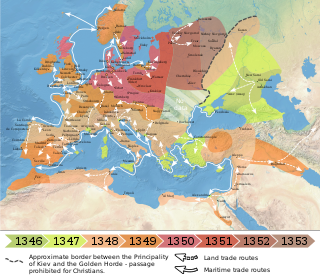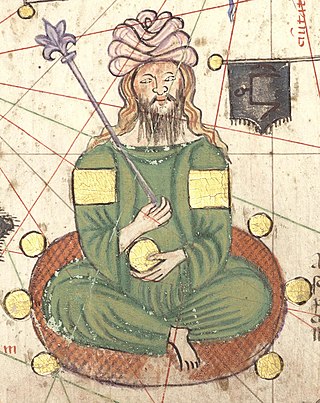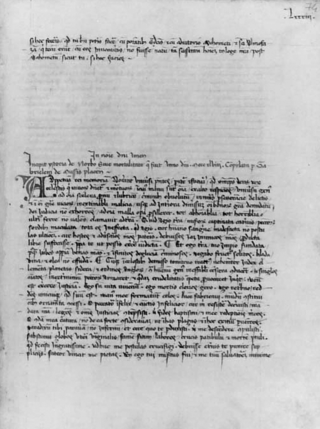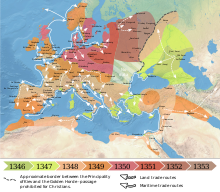
The Black Death was a bubonic plague pandemic occurring in Europe from 1346 to 1353. One of the most fatal pandemics in human history, as many as 50 million people perished, perhaps 50% of Europe's 14th century population. Bubonic plague is caused by the bacterium Yersinia pestis and spread by fleas. One of the most significant events in European history, the Black Death had far-reaching population, economic, and cultural impacts. It was the beginning of the second plague pandemic. The plague created religious, social and economic upheavals, with profound effects on the course of European history.

Giovanni Boccaccio was an Italian writer, poet, correspondent of Petrarch, and an important Renaissance humanist. Born in the town of Certaldo, he became so well known as a writer that he was sometimes simply known as "the Certaldese" and one of the most important figures in the European literary panorama of the fourteenth century. Some scholars define him as the greatest European prose writer of his time, a versatile writer who amalgamated different literary trends and genres, making them converge in original works, thanks to a creative activity exercised under the banner of experimentalism.
The 1340s was a decade that began on 1 January 1340 and ended on 31 December 1349. It was in the midst of a period in human history often referred to as the Late Middle Ages in the Old World and the pre-Columbian era in the New World.

Messina is a harbour city and the capital of the Italian Metropolitan City of Messina. It is the third largest city on the island of Sicily, and the 13th largest city in Italy, with a population of more than 218,000 inhabitants in the city proper and about 650,000 in the Metropolitan City. It is located near the northeast corner of Sicily, at the Strait of Messina and it is an important access terminal to Calabria region, Villa San Giovanni, Reggio Calabria on the mainland. According to Eurostat the FUA of the metropolitan area of Messina has, in 2014, 277,584 inhabitants.

Gazaria was the name given to the colonial possessions of the Republic of Genoa in Crimea and around the Black Sea coasts in the territories of the modern regions of Russia, Ukraine and Romania, from the mid-13th century to the late 15th century. The Genoese rule was represented by the Consul, and the capital of the Gazaria was the city of Kaffa in the Crimean peninsula.

Jani Beg, also known as Janibek Khan, was Khan of the Golden Horde from 1342 until his death in 1357. He succeeded his father Öz Beg Khan.

Louis the Child was King of Sicily from 15 September 1342 until his death. He was a minor upon his succession, and was under a regency until 1354. His actual rule was short, for he died in an outbreak of plague the next year. His reign was marked by civil war.

The Great Plague of Marseille, also known as the Plague of Provence, was the last major outbreak of bubonic plague in Western Europe. Arriving in Marseille, France, in 1720, the disease killed over 100,000 people: 50,000 in the city during the next two years and another 50,000 to the north in surrounding provinces and towns.

The Black Death peaked in Europe between 1348 and 1350, with an estimated third of the continent's population ultimately succumbing to the disease. Often simply referred to as "The Plague", the Black Death had both immediate and long-term effects on human population across the world as one of the most devastating pandemics in human history, including a series of biological, social, economic, political and religious upheavals that had profound effects on the course of world history, especially European history. Symptoms of the Bubonic Plague included painful and enlarged or swollen lymph nodes, headaches, chills, fatigue, vomiting, and fevers, and within 3 to 5 days, 80% of the victims would be dead. Historians estimate that it reduced the total world population from 475 million to between 350 and 375 million. In most parts of Europe, it took nearly 80 years for population sizes to recover, and in some areas, it took more than 150 years.

The Nuova Cronica or New Chronicles is a 14th-century history of Florence created in a year-by-year linear format and written by the Italian banker and official Giovanni Villani. The idea came to him in the year 1300, after attending Rome's first Jubilee. Villani realized that Rome's many historical achievements were well-known and desired to lay out a history of the origins of his own city of Florence. In his Cronica, Villani described in detail the many building projects of the city, statistical information on population, ordinances, commerce and trade, education, and religious facilities. He also described several disasters such as famines, floods, fires, and the pandemic of the Black Death in 1348, which would take his own life. Villani's work on the Nuova Cronica was continued by his brother Matteo and his nephew Filippo after his death. It has been described as the first introduction of statistics as a positive element in history.
Agnolo di Tura was a chronicler from Siena, Italy. He was also a shoemaker and tax collector. He married a woman named Nicoluccia, who was of a higher class than he was. Together Agnolo and Nicoluccia had five children. During the time of the Black Death which arrived in Siena in May 1348, Nicoluccia and all five children died. Agnolo di Tura survived the Black Death and remarried.

The Black Death was one of the most devastating pandemics in human history, resulting in the deaths of an estimated 75 to 200 million people in Eurasia, and peaking in Eurasia from 1321 to 1353. Its migration followed the sea and land trading routes of the medieval world. This migration has been studied for centuries as an example of how the spread of contagious diseases is impacted by human society and economics.

The Black Death (1346–1353) had great effects on the art and literature of medieval societies that experienced it.

The Black Death was a bubonic plague pandemic, which reached England in June 1348. It was the first and most severe manifestation of the second pandemic, caused by Yersinia pestis bacteria. The term Black Death was not used until the late 17th century.

The Cronaca fiorentina di Marchionne di Coppo Stefani written by Baldassarre Bonaiuti is considered one of the best works written on the Black Death in Florence in the year 1348. It is the only known literary work by Bonaiuti. It was written in vulgar Latin. There is no information as to when he may have started his work, but he devoted much time on it in his retirement from about 1378 until his death, a period of seven years.

The second plague pandemic was a major series of epidemics of plague that started with the Black Death, which reached medieval Europe in 1346 and killed up to half of the population of Eurasia in the next four years. It followed the first plague pandemic that began in the 6th century with the Plague of Justinian, but had ended in the 8th century. Although the plague died out in most places, it became endemic and recurred regularly. A series of major epidemics occurred in the late 17th century, and the disease recurred in some places until the late 18th century or the early 19th century. After this, a new strain of the bacterium gave rise to the third plague pandemic, which started in Asia around the mid-19th century.

Gabriel de Mussis — in Italian, Gabriele de' Mussi — was a notary from Piacenza, Italy, who gave a vivid account of the start of the Black Death in the Black Sea city of Kaffa and its spread to Sicily and Piacenza. His account in Latin, entitled Istoria de Morbo sive Mortalitate quae fuit Anno Dni MCCCXLVIII, is preserved in a manuscript in the library of the University of Wroclaw.

Several epidemics from the plague struck Malta from the medieval era until 1945, claiming almost 20,000 victims in at least ten epidemics over 350 years. After the first epidemics, preventive measures were installed, including a very active lazaret which issued patents of non-contagion for many ships plying the Mediterranean.

The Black Death was present in the Middle East between 1347 and 1349. The Black Death in the Middle East is described more closely in the Mamluk Sultanate, and to a lesser degree in Marinid Sultanate of Morocco, the Sultanate of Tunis, and the Emirate of Granada, while information of it in Iran and the Arabian Peninsula is lacking. The Black Death in Cairo, at the time the biggest city in the Mediterranean region, was one of the biggest documented demographic catastrophes during the Black Death.
The Siege of Caffa was a siege of the Genoese port town of Caffa by a large Crimean Tatar army under the Golden Horde, led by their Khan Jani Beg, which is known largely for its role in spreading a pandemic. The Mongol army allegedly threw the bodies of Mongol warriors who had died of plague over the walls of the besieged city, which is considered one of the earliest examples of biological warfare. In Gabriel de Mussis' writings, the Black Death was alleged to have reached Europe from the Crimea as the result of biological warfare during the siege.


















